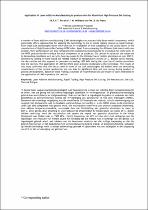 ResearchSpace
ResearchSpace
Application of laser additive manufacturing to produce dies for aluminium high pressure die casting
JavaScript is disabled for your browser. Some features of this site may not work without it.
- ResearchSpace
- →
- Research Publications/Outputs
- →
- Journal Articles
- →
- View Item
| dc.contributor.author |
Pereira, MFVT

|
|
| dc.contributor.author |
Williams, M

|
|
| dc.contributor.author |
Du Preez, WB

|
|
| dc.date.accessioned | 2012-08-27T07:05:22Z | |
| dc.date.available | 2012-08-27T07:05:22Z | |
| dc.date.issued | 2012-07 | |
| dc.identifier.citation | Pereira, MFVT, Williams, M and Du Preez, WB. 2012. Application of laser additive manufacturing to produce dies for aluminium high pressure die casting. South African Journal of Industrial Engineering, vol. 23(2), pp 147-158 | en_US |
| dc.identifier.issn | 1012-277X | |
| dc.identifier.uri | http://sajie.journals.ac.za/pub/article/view/337/282 | |
| dc.identifier.uri | http://hdl.handle.net/10204/6065 | |
| dc.description | South African Journal of Industrial Engineering, vol. 23(2), pp 147-158. This work is licensed under a Creative Commons Attribution 3.0 License. | en_US |
| dc.description.abstract | A number of laser additive manufacturing (LAM) technologies can produce fully-dense metal components that potentially offer opportunities to apply the technology in die or mould making (known as rapid tooling). From these LAM technologies, three were selected for evaluation of their suitability as die cavity inserts in the manufacture of high pressure die-casting (HPDC) dies. Apart from comparing the different LAM inserts with one another, their performance was also compared with components manufactured in a standard hot work steel. In the HPDC process, the die is unique to each component to be produced. Die cavities in particular are subjected to demanding conditions, such as cyclic heating caused by the introduction of molten aluminium at over 650°C, followed by cooling in water-based die release medium at temperatures around 25°C. Besides cyclic heating, the die cavities are also exposed to pressures exceeding 1500 MPa during the injection of molten aluminium into the cavities. This application of LAM, therefore, poses extreme challenges to the technology. The results of this study confirmed that the metals used in some of the LAM technologies did indeed meet the demanding requirements of the current application, and can lead to significant time- and cost-saving during product or process developments. Based on these findings, a number of recommendations are made for users interested in the application of LAM to produce die cavities. | en_US |
| dc.language.iso | en | en_US |
| dc.publisher | Southern African Institute for Industrial Engineering | en_US |
| dc.relation.ispartofseries | Workflow;9456 | |
| dc.subject | Laser additive manufacturing | en_US |
| dc.subject | LAM | en_US |
| dc.subject | Rapid tooling | en_US |
| dc.subject | High pressure die casting | en_US |
| dc.subject | Die manufacture | en_US |
| dc.subject | Die life | en_US |
| dc.subject | Thermal fatigue | en_US |
| dc.title | Application of laser additive manufacturing to produce dies for aluminium high pressure die casting | en_US |
| dc.type | Article | en_US |
| dc.identifier.apacitation | Pereira, M., Williams, M., & Du Preez, W. (2012). Application of laser additive manufacturing to produce dies for aluminium high pressure die casting. http://hdl.handle.net/10204/6065 | en_ZA |
| dc.identifier.chicagocitation | Pereira, MFVT, M Williams, and WB Du Preez "Application of laser additive manufacturing to produce dies for aluminium high pressure die casting." (2012) http://hdl.handle.net/10204/6065 | en_ZA |
| dc.identifier.vancouvercitation | Pereira M, Williams M, Du Preez W. Application of laser additive manufacturing to produce dies for aluminium high pressure die casting. 2012; http://hdl.handle.net/10204/6065. | en_ZA |
| dc.identifier.ris | TY - Article AU - Pereira, MFVT AU - Williams, M AU - Du Preez, WB AB - A number of laser additive manufacturing (LAM) technologies can produce fully-dense metal components that potentially offer opportunities to apply the technology in die or mould making (known as rapid tooling). From these LAM technologies, three were selected for evaluation of their suitability as die cavity inserts in the manufacture of high pressure die-casting (HPDC) dies. Apart from comparing the different LAM inserts with one another, their performance was also compared with components manufactured in a standard hot work steel. In the HPDC process, the die is unique to each component to be produced. Die cavities in particular are subjected to demanding conditions, such as cyclic heating caused by the introduction of molten aluminium at over 650°C, followed by cooling in water-based die release medium at temperatures around 25°C. Besides cyclic heating, the die cavities are also exposed to pressures exceeding 1500 MPa during the injection of molten aluminium into the cavities. This application of LAM, therefore, poses extreme challenges to the technology. The results of this study confirmed that the metals used in some of the LAM technologies did indeed meet the demanding requirements of the current application, and can lead to significant time- and cost-saving during product or process developments. Based on these findings, a number of recommendations are made for users interested in the application of LAM to produce die cavities. DA - 2012-07 DB - ResearchSpace DP - CSIR KW - Laser additive manufacturing KW - LAM KW - Rapid tooling KW - High pressure die casting KW - Die manufacture KW - Die life KW - Thermal fatigue LK - https://researchspace.csir.co.za PY - 2012 SM - 1012-277X T1 - Application of laser additive manufacturing to produce dies for aluminium high pressure die casting TI - Application of laser additive manufacturing to produce dies for aluminium high pressure die casting UR - http://hdl.handle.net/10204/6065 ER - | en_ZA |





